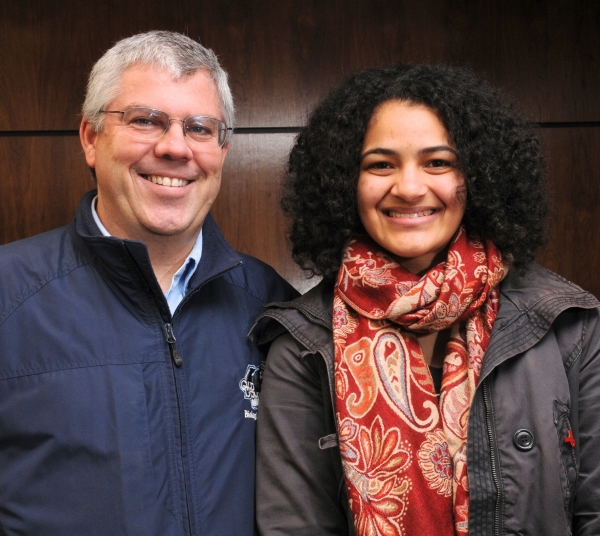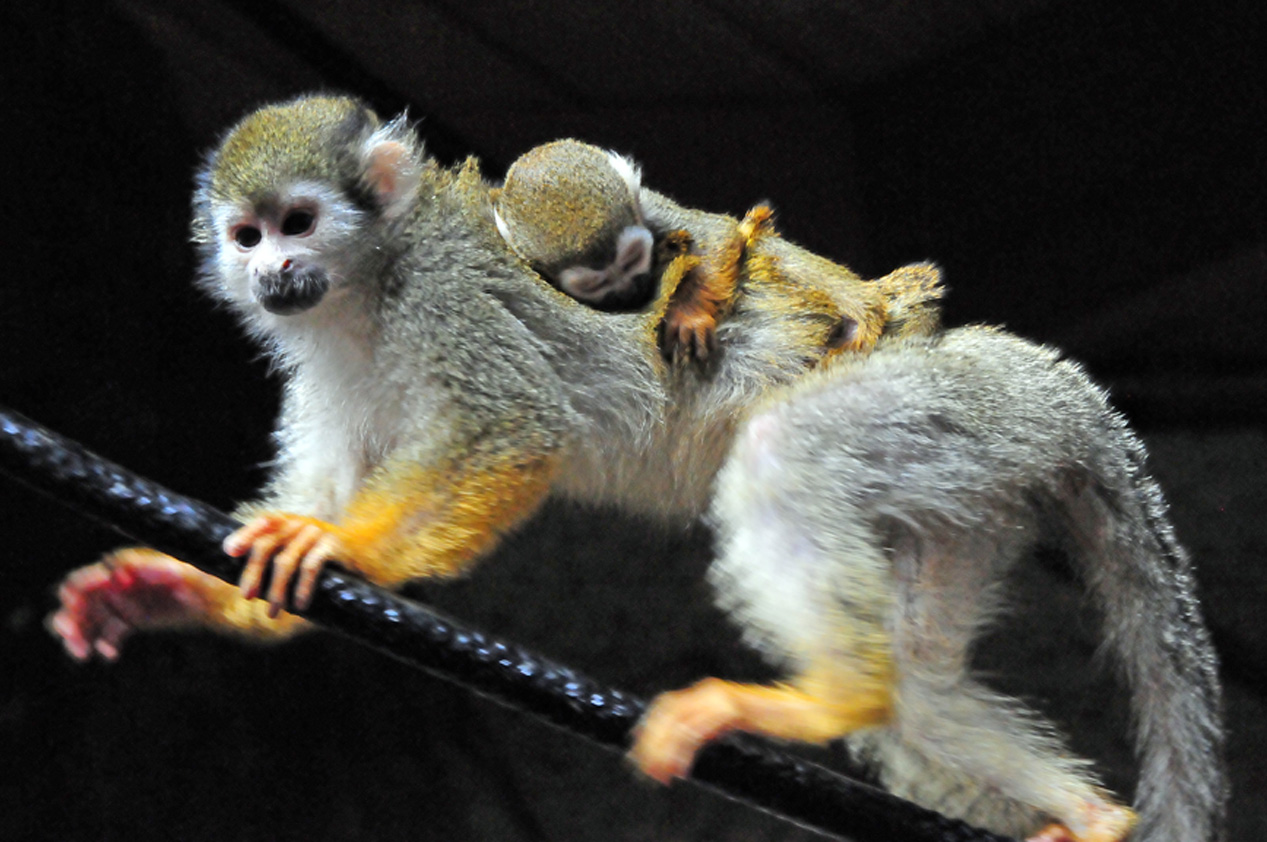'Very Special' Biology Student Does Award-Winning Study of Virginia Zoo Monkeys
March 28, 2013
Busy is better for Old Dominion University biology major LaCheryl Ball, and it seems that the same is true for the squirrel monkeys she is working with at the Virginia Zoo.
Ball, who is from Henrico County outside Richmond, will be the first member of her family to get a college degree when she graduates in May as an honors student headed for veterinary school.
"She is a very special student at our university," said Eric Walters, the assistant professor of biological sciences who has assisted in her national award-winning research at the zoo in Norfolk. Ball decided as a sixth grader that she wanted to work with animals as a career, and she steadfastly held to that course despite family disruption, including the death of a parent, while she was in high school.
Although she is a scholarship student at ODU, Ball has needed to hold down paying jobs to stay in school. But even her employment has helped to keep her career aspirations on track: one of her jobs has been at a veterinary clinic.
She served a summer-long internship at the New England Wildlife Center in Boston, having to walk four miles back and forth to work because she lacked personal transportation. Also while at ODU she has volunteered at local humane societies, founded the Pre-Veterinary Medical Association and mentored middle school girls who are interested in science. "The list could go on," Walters said.
Later this year, Ball will begin studies at the Virginia-Maryland Regional College of Veterinary Medicine, which incorporates facilities at Virginia Tech, the University of Maryland and the Marion DuPont Scott Equine Medical Center in Leesburg, Va.
So that explains how busy she likes to be. What about the squirrel monkeys?
Her research in that area - involving puzzle-solving to get food, and the way this challenge seems to stimulate the monkeys - is a big reason she is the winner this spring of a national award from the Charles H. Turner Program of the Animal Behavior Society and the Center for Integrative Study of Animal Behavior. The award, named for one of the first African Americans to do animal behavior research, goes to 10 outstanding undergraduate researchers each year. It will pay all expenses for Ball to attend the Animal Behavior Society conference in July in Boulder, Colo., where she will present her research and be advised by some of the country's top people in her chosen field.
Ball's research project got its start soon after Walters came to the university two years ago. "It was happenstance, really," he said. "She came to me and wanted to know if I would be teaching a course in mammalogy. I told her no, but that I could work with her. I knew she was interested in vet school and wanted more background in mammals," Walters said. "I told her I was working with the Virginia Zoo and we are interested in collaborations between the zoo and ODU."
From Walters' contact with zoo officials, he learned that they were eager to participate in a so-called "enrichment" research project. This met Ball's needs, as well.
Enrichment is not new to zookeeping. Most modern zoos spend a lot of time and money trying to persuade their animals to be more active, and to use the full space available to them. This can include trying to coax the animals into the foraging behavior that they would exhibit in the wild.
"The challenge for zookeepers is to get animals away from captive behaviors, which can be negative, like an orangutan sitting around pulling his hair out," Walters said. "You want to stimulate the animals, give them choices. Food is one way to do this. Do they eat what you put in their bowls or do they solve a puzzle to get at their food?"
Ball and Walters consulted with various people at the zoo, including veterinarian Amanda Guthrie, and came up with a project that would tempt the squirrel monkeys to manipulate a contraption in order to get at the fruits, vegetables and small-primate chow that captive monkeys usually have no difficulty getting from bowls placed around their quarters. The feeder is a Plexiglas box with screws and levers that is made by a manufacturer specifically for this kind of research.
There was a strict, every-other-day schedule when the box was hung for a few hours high, as in a tree, in the squirrel monkey enclosure. Some of the six monkeys in the exhibit were up to the challenge more than others. Especially fond of it were the two juvenile males - "like teenagers taking to technology," explained Ball.
"The experiment is divided into three phases," Ball added. "The first defines their behavior before enrichment," which means that she carefully observed the behavior of the monkeys before the food puzzle was installed. "The second explores their behavior during enrichment on both treatment days, when the enrichment feeders are present, and on control days when the feeders are not in the exhibit. The third phase is unique in that it explores the protracted effects of the enrichment on this species in captivity."
Last week, Ball was painstakingly charting the monkeys' behavior in the third phase of the study. And, so far, the results are interesting.
"The goal of my experiment is to give the monkeys an incentive or provide a means for them to behave more similarly to monkeys of their species in the wild. (These monkeys are native to Central and South America.)
"I am trying to get them to exhibit foraging behaviors approximately 61 percent of the time, such as is seen in the wild," Ball said. "I am also trying to increase the active behaviors - climbing, crawling, interacting, etc. - exhibited by the population. So far, I have seen a 14 percent increase in foraging behaviors in the presence of enrichment and also a 5.2 percent increase in active behaviors."
Roger Sweeney, assistant director of the zoo, said the "research part" of Ball's project is what is so valuable to the facility. "We are familiar with doing things to try to make life more interesting for the animals, challenging them mentally, getting them to move about. But we seem to never have enough people to follow through. We know how to stimulate them and get the burst of energy, and we get excited about that. But does the behavior last? What we know tends to be anecdotal."
Ball's research will chart the aftermath of the enrichment exercise, and help determine what sort of enrichment can have a long-term, positive impact on the animals' behavior.
"LaCheryl is delivering what we struggle to get," said Sweeney. "Her work definitely meets our needs for a proper assessment."
Walters said he finds fascinating a tangential observation by Ball. After the three weeks of enrichment feeding, when she was looking for lasting effects, she found a specific one right away. "It was like some of the monkeys remembered. There was an increase in foraging behavior on the day when the boxes would have been there and less so on the alternate days when they weren't supposed to be there."
The professor said he is proud of Ball, not only because of the quality of her schoolwork and research, or of her extracurricular activities, but also because she is making a statement as an African American woman in a STEM (science, technology, engineering and math) field. "Animal behavior long was a man's field, and then women came to dominate. But not African American men or women. There is very little diversity, and she can help change that."


 Eric Walters and LaCheryl Ball
Eric Walters and LaCheryl Ball
 Squirrel monkey, Madonna, with her recent offpring, at Virginia Zoo.
Squirrel monkey, Madonna, with her recent offpring, at Virginia Zoo.
